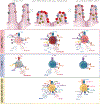New Insights on Genes, Gluten, and Immunopathogenesis of Celiac Disease
- PMID: 38670280
- PMCID: PMC11283582
- DOI: 10.1053/j.gastro.2024.03.042
New Insights on Genes, Gluten, and Immunopathogenesis of Celiac Disease
Abstract
Celiac disease (CeD) is a gluten-induced enteropathy that develops in genetically susceptible individuals upon consumption of cereal gluten proteins. It is a unique and complex immune disorder to study as the driving antigen is known and the tissue targeted by the immune reaction can be interrogated. This review integrates findings gained from genetic, biochemical, and immunologic studies, which together have revealed mechanisms of gluten peptide modification and HLA binding, thereby enabling a maladapted anti-gluten immune response. Observations in human samples combined with experimental mouse models have revealed that the gluten-induced immune response involves CD4+ T cells, cytotoxic CD8+ T cells, and B cells; their cross-talks are critical for the tissue-damaging response. The emergence of high-throughput technologies is increasing our understanding of the phenotype, location, and presumably function of the gluten-specific cells, which are all required to identify novel therapeutic targets and strategies for CeD.
Keywords: B Cells; CD4(+) T Cells; Celiac Disease; Gluten; HLA; Intraepithelial CD8(+) T Cells; Transglutaminase 2; Villous Atrophy.
Copyright © 2024 AGA Institute. Published by Elsevier Inc. All rights reserved.
Figures




References
-
- Abadie V, Sollid LM, Barreiro LB, Jabri B. Integration of genetic and immunological insights into a model of celiac disease pathogenesis. Annu Rev Immunol 2011;29:493–525. - PubMed
-
- Singh P, Arora A, Strand TA, et al. Global Prevalence of Celiac Disease: Systematic Review and Meta-analysis. Clin Gastroenterol Hepatol 2018;16:823–836 e2. - PubMed
-
- Lebwohl B, Sanders DS, Green PHR. Coeliac disease. Lancet 2018;391:70–81. - PubMed
-
- Lindfors K, Ciacci C, Kurppa K, et al. Coeliac disease. Nat Rev Dis Primers 2019;5:3. - PubMed
Publication types
MeSH terms
Substances
Grants and funding
LinkOut - more resources
Full Text Sources
Medical
Research Materials

